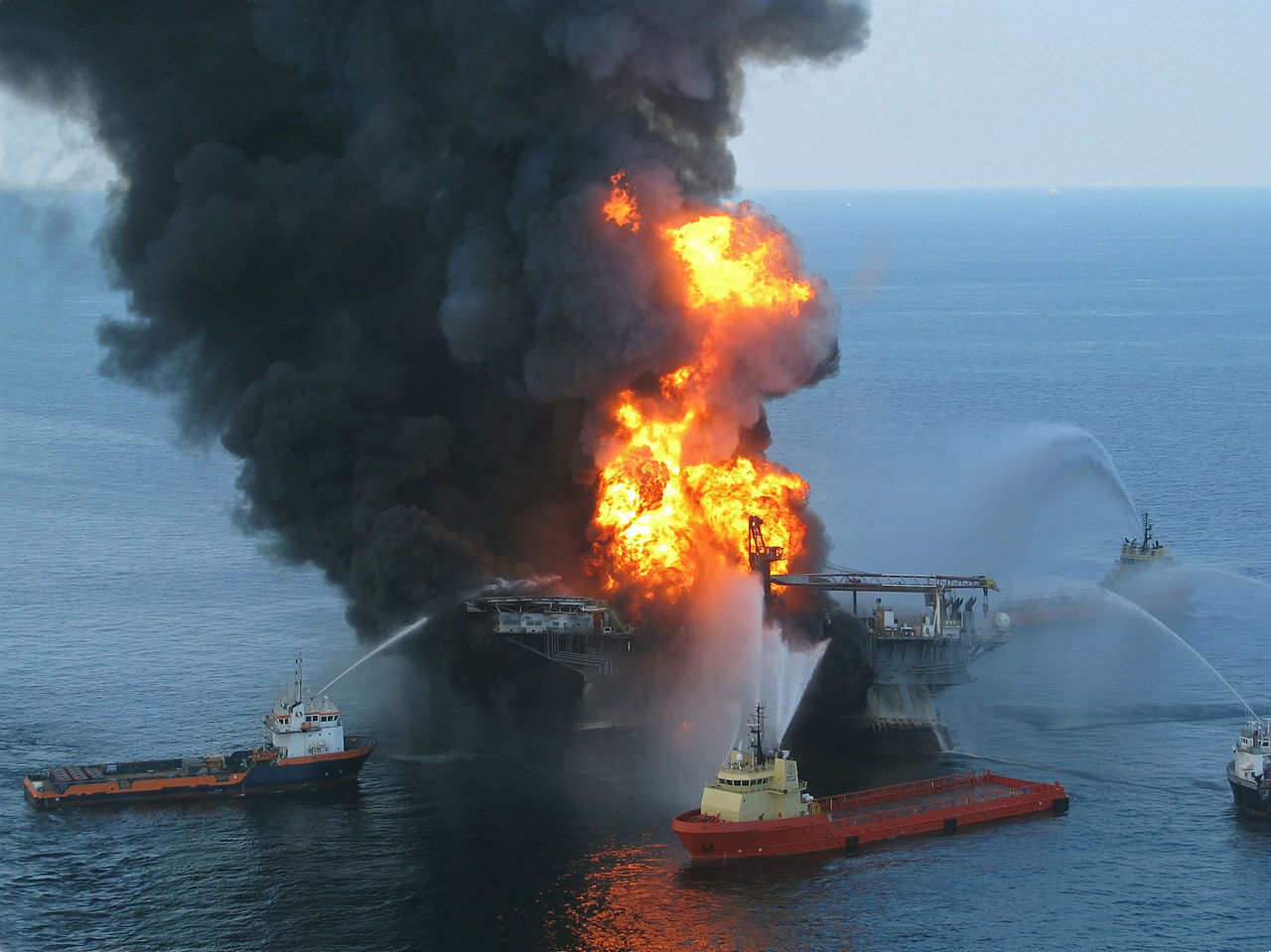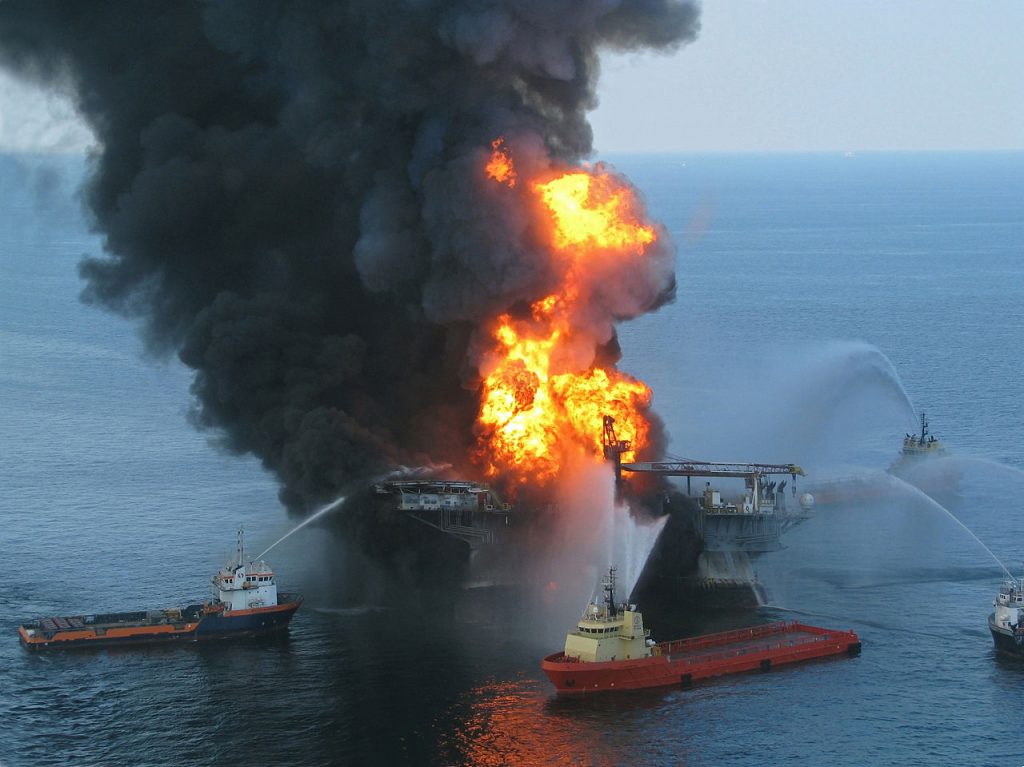
By Christopher Lavers
Crude oils, fuels and petroleum derivatives and their decay products clearly adversely impact earth’s natural environment. It is now almost exactly a decade on from the Deepwater Horizon oil spill in April 2010, yet recent published research from the University of Miami [1] has shown a toxic and invisible oil spill spread went much farther than the known satellite footprint at the time. The spill had a significant environmental impact, and the latest research has implications for maritime health for future oil disasters. During the Deepwater Horizon blowout some 149,000 square kilometres of the Gulf of Mexico was covered by oil, with vast areas of the Gulf closed to fishing. Researchers focused on toxic on biota marine organism oil concentration ranges, finding areas well outside the previously defined spill area were impacted.
In the marine industry oil pollution poses a serious threat to ocean ecology. Thousands of tonnes of oil are spilled every year due to anthropogenic causes, e.g.: tanker accidents, rupture of pipelines, malfunctioning of oil extraction platforms, as well as natural events such as seabed seepage. Oil spills surveillance is an important part of spillage contingency planning. Accurate detection and forecasting of spillage movement is important to fisheries, wildlife, resolving disputes related to liability, and resource management for conservation of the marine environment. The different methods of detecting and monitoring oil spills use vessels, aircraft, satellites, and lately unmanned drones. Vessels, equipped with imaging radar can detect oil at sea, but cover a limited area. Remote sensing from aircraft increases the sensing “footprint” and is the commonest type of oil tracking, although remote sensing from satellites using radar is becoming a more common technique.
Protection of the marine environment is regulated by the MARPOL Convention. To police this convention, an efficient system to detect pollutants, and identify and punish polluters, is critical. Identification of pollutant and polluter can be achieved by sampling oil from suspect sources. This is a key element of the process and detection is starting to incorporate high resolution satellite imagery, along with time and date stamps from vessel Automatic Identification System (AIS) data. To conduct checks on the pollution emitted and ensure any consequences fall on the offending vessel, there is urgent requirement to develop sensors to detect harmful chemicals and maritime environmental hazards. There are clear applications here for optical waveguides, such as optical fibres, sensitive to changes, including refractive index, absorption, and Ultra Violet (UV) light. These can be used as sensors to detect specific biological and chemical agents or changes due to incident radiation. Waveguides can detect UV induced fluorescence generated from thin water oil films. In this regard work at the Dartmouth Centre for Seapower and Strategy may prove useful.
DCSS Oil Detection with UV
Oil detection on water is of pressing maritime interest. It can be done
using a wide range of spectral techniques including:
- Satellite-based sensing,
- UV fluorescence, and
UV reveals materials which generate fluorescence. When exposed to UV, they are excited momentarily to higher energy states, and upon relaxation drop back to their ‘ground’ state, emitting the energy difference at visible wavelengths with unique fluorescence spectra. Clothes often contain fluorescent substances that respond to UV in sunlight or under illumination at music events. Similarly, oil is detected on seawater through UV induced fluorescence. Shining a 355nm UV laser on to a water surface results in oils emitting blue fluorescence. Oil free water remains dark on imagery. By contrast, LIDAR (a detection system which works on the principle of radar, but uses laser light) returns from oil free water with low backscattered visible fluorescence levels.
Identifying Oil Polluters
The concept of using fluorescence to detect and identify crude oil was reported in the 1970s. Oil fluorescence spectra studies confirmed crude oil types display different spectra, weathered or fresh, between 220-280nm. Fluorescence from small samples of man-made petroleum products subjected to UV illumination can generate specific spectral ‘fingerprints’. One company now uses unique synthetic DNA tracers to mitigate oil pollution; introducing synthetic DNA into a vessel’s tanks, allowing them to identify a vessel’s unique registration number from sea recovered oil in the event of a spill.
Developing Fluorosensors
To make the most of such developments, the industry needs to develop field operated devices able to identify oil and other chemical pollutants. These should be usable by unskilled personnel under potentially hazardous conditions, and provide accurate and rapid results without need for distant measurement standard laboratories. Because UV is regarded as harmful to those working outdoors or at sea in a harsh maritime environment, high power UV lasers must be avoided. We investigated the feasibility of developing planar optical waveguides (figure 1) to ‘capture’ UV induced fluorescence from thin oil films, having observed irradiation effects upon waveguides to detect UV, and gamma-ray exposure, in hostile environments, and an ammonia pH sensor. Such devices allow analysis of thin films deposited onto waveguides and surrounding fluid or analyte. If optically absorbent coatings are placed on waveguides, light is attenuated over its interaction length. Thin film or solution properties alter detected output optical power.
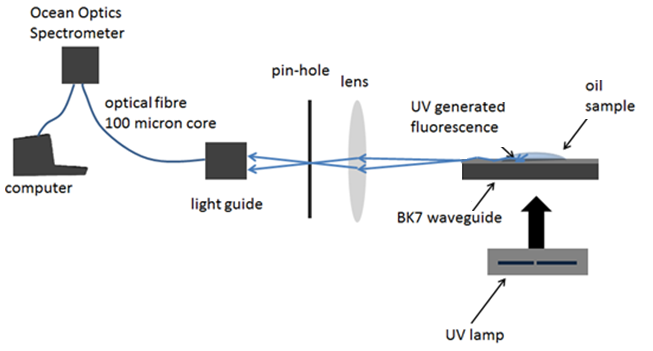
Testing the sensors
Two oils, one vegetable (extra virgin olive oil Primadonna), the second a refined petrochemical oil (CastrolTM GTXTM BP Product, 15W-40), served as analytes for potential applications. Figure 2 shows the different fluorescent spectra for each oil, with UV spectra separated easily into vegetable, and very light refined oil. Results from traditional UV induced fluorescence methods are shown for comparison (figure 3). The ‘very light refined oil’ referenced here has similar fluorescence spectra to the Castrol oil used, having higher intensity between 340-380nm than vegetable oil.
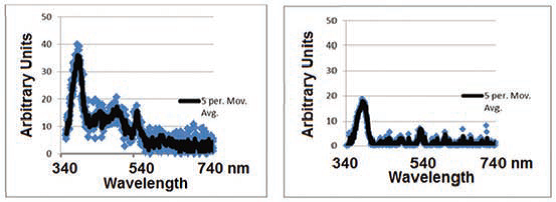
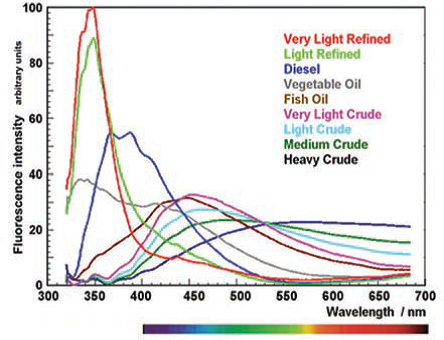

Future applications
Application of a Desktop waveguide-coupled fluorosensor shows promise for small volume sample measurement with fluorescent oils or labelled molecules for biological sensing, as opposed to large ocean-scale monitoring with high power lasers. Combining DNA analysis with fluorescence should provide greater identification accuracy. Optical fluorescence is strongly dependent on the specific oil and evanescent wave field strength. Large scattering losses can render integrated optical devices inoperative. Sensitivity, as well as scattering loss, are connected closely with the evanescent field. A strong evanescent wave field is responsible for high sensitivity, a mechanism resulting in high scattering loss. Our method uses pre-polished BK7 waveguides to validate fluorescence detection, distinguish oil types, and we will examine a range of other products. UV fluorosensors may lead to proactive remotely deployed miniature optical waveguide environmental sensors, environmental waveguide in MarPol applications, before the next major maritime oil spill disaster takes place.
[1] I Berenshtein, C B Paris, N Perlin, M M Alloy, SB Joye, and S Murawski, Invisible oil beyond the Deepwater Horizon satellite footprint, Science Advances 12 Feb 2020, Vol. 6, no. 7, eaaw8863 DOI:10.1126/sciadv.aaw8863 (Accessed 20/02/2020).

